
‘Spangle’ Pendant
Mid 6th-Mid 7th Century AD
Metal
Trapezoid “spangle” made of white washed metal sheet, with punched dots around the edges. This may have been worn on a necklace, or it could have been mounted on another object as decoration.
Reference: CANCM:1978.3.1120
Can be found: Top Shelf in Explorers and Collectors Collection




































































Amber Beads
5th – 8th Century AD
Amber
Necklace of 12 amber beads, of various shapes and sizes. Amber was likely imported from the Baltic, and would have been expensive to purchase; these beads would have belonged to someone very wealthy.
Found at Eastry, Kent, by Mr. Irby. Presented to the museum by Dr. W.G. Urry
Reference: CANCM:7509
Can be found: Bottom Shelf in Explorers and Collectors Collection




































































Amethyst beads
5th – 8th Century AD
Amethyst
String of 14 amethyst beads. Amethyst beads, mainly from trade routes that led through Germany, are more commonly found in Kent than elsewhere in the country.
Found by Mr. J. Brent.
Reference: CANCM:2139
Can be found: Middle Shelf in Explorers and Collectors Collection




































































Ansate Brooch
5th-8th Centuries AD
Copper Alloy
Brooch. This type of brooch is sometimes called a ‘caterpillar’ brooch on account of their shape.
Presented by Canterbury Archaeological Trust
Reference: CANCM:1980.12.719
Can be found: Top Shelf in Explorers and Collectors Collection




































































Bead
5th – 8th Century AD
Glass
Glass Bead.
Reference: Found in Canterbury in 1979 by Mr A. Waters. No accession number
Can be found: Top Shelf in Explorers and Collectors Collection




































































Beads
5th – 8th Century AD
Glass and Copper Alloy
Brass wire strung with two opaque yellow ‘annular’ beads and one unpolished cobalt blue ‘annular’ bead. This may have been a breast ornament – it would have been pinned onto a piece of clothing.
Reference: CANCM:1978.3.174
Can be found: Top Shelf in Explorers and Collectors Collection




































































Beads
5th – 8th Century AD
Glass and stone
String of beads.
Found at Westbere Anglo-Saxon cemetery, Kent. Bequeathed by Osborn Dan
Reference: CANCM:6425
Can be found: Middle Shelf in Explorers and Collectors Collection




































































Beads
5th – 8th Century AD
Glass and stone
String of 69 beads of various colours.
Found in a grave at field coll place, Grove Ferry, Kent.
Reference: CANCM:1976
Can be found: Middle Shelf in Explorers and Collectors Collection




































































Beads
5th – 8th Century AD
Glass and stone
Necklace containing four cylindrical (bugle) beads and what were originally quadruple pearl-like beads, some of which have since separated into single, double and triple beads.
Found at Eastry, Kent by Mr. Irby. Presented to the museum by Dr. W.G. Urry
Reference: CANCM:7511
Can be found: Bottom Shelf in Explorers and Collectors Collection




































































Bell Beaker
6th Century AD
Glass
Carinated glass Bell-Beaker with fine white trials below the rim, and on the base. As this glass has no base, it has been suggested it was used for toasts at feasts; the drink would have had to be downed in one go.
Found in Westbere (Anglo-Saxon cemetery) Kent, UK. Bequeathed by Osborn Dan.
Reference: CANCM:6430
Can be found: Middle Shelf in Explorers and Collectors Collection




































































Bird Brooch
5th – 8th Century AD
Silver Gilt
Bird brooch, silver gilt, garnet inset in eye and tail, niello inlay.
Found in Bekesbourne, Kent, UK. by Mr. P.G. Wilson.
Reference: CANCM:7523
Can be found: Middle Shelf in Explorers and Collectors Collection


Bird Brooch
5th – 8th Century AD
Silver Gilt
Bird brooch, silver gilt, garnet inset in eye and tail, niello inlay.
Found in Bekesbourne, Kent, UK. by Mr. P.G. Wilson.
Reference: CANCM:7524
Can be found: Middle Shelf in Explorers and Collectors Collection




































































Bird Brooch
5th-8th Century AD
Gilded Copper Alloy
Bird shaped brooch of a Frankish type, with traces of gilt on the exterior.
Found at Eastry, Kent in 1792. Presented to the museum by Dr. W.G. Urry after a loan from Mr Irby
Reference: CANCM:7496.
Can be found: Bottom Shelf in Explorers and Collectors Collection




































































Bracteates
5th – 8th Century AD
Gold
Kentish bracteates. Bracteates, thin single-sided gold medals, were worn as pendants on a string around the neck. They may have been seen as a protective amulet.
Bequeathed by Mr. J. Brent.
Reference: CANCM:2159, 2160
Can be found: Middle Shelf in Explorers and Collectors Collection




































































Bronze Patera Bowl
7th Century AD
Copper Alloy
‘Coptic bowl’. Bowls of this type have been found in several other Anglo-Saxon cemetaries in Kent. They were made in Egypt, and probably were imported from Alexandria in the seventh century AD, arriving to Britain via the river Rhine.
Thought to be from Wickhambreaux (1886).
Bequeathed by Lt. Col Copeland.
Reference: CANCM:1107
Can be found: Bottom Shelf in Explorers and Collectors Collection




































































Brooch
5th – 8th Century AD
Copper Alloy
Equal arm brooch, set with garnets in gilt copper.
Found in Bourne Park, Kent, UK. by Mr. T. Sewell.
Reference: CANCM:1991.80.1
Can be found: Top Shelf in Explorers and Collectors Collection




































































Brooch
5th – 8th Century AD
Silver
Rare Kentish silver brooch of cruciform shape.
Found by Mr. J. Brent.
Reference: CANCM:2660
Can be found: Middle Shelf in Explorers and Collectors Collection


Brooch
5th – 8th Century AD
Copper Alloy
Bronze gilt brooch of Jutish type without a pin.
Reference: CANCM:2651
Can be found: Middle Shelf in Explorers and Collectors Collection




































































Brooch
Early 6th Century
Copper Alloy
Electroform copy of bronze gilt brooch - the original is at the British Museum. The earliest Saxons regularly used almost abstract animal designs on their jewellery.
Found in Martyr’s Field in 1900.
Reference: CANCM:nono
Can be found: Middle Shelf in Explorers and Collectors Collection




































































Brooch
5th – 8th Century AD
Copper Alloy, silver and garnet
Circular silver jewelled disc brooch of Kentish work set with garnets; cloisonee work and gold wire filigree.
Collected by Mr. J. Brent. Found in Anglo Saxon cemetery at Stouting, Faversham.
Reference: CANCM:2614
Can be found: Middle Shelf in Explorers and Collectors Collection


Brooch
5th – 8th Century AD
Copper Alloy
Bronze brooch of foreign type, possibly from Belgium or the Lower Rhine region of Germany.
Reference: CANCM:2634
Can be found: Middle Shelf in Explorers and Collectors Collection




































































Brooch
5th – 8th Century AD
Silver Gilt
Silver-gilt brooch with garnet and greenstone.
Found at Eastry, Kent in 1792. Presented to the museum by Dr. W.G. Urry after a loan from Mr Irby
Reference: CANCM:7497
Can be found: Bottom Shelf in Explorers and Collectors Collection




































































Brooch
5th – 8th Century AD
Copper-Alloy
Square brooch set with garnets at each corner.
Found at Mersham, Kent in 1828.
Reference: CANCM:2631
Can be found: Bottom Shelf in Explorers and Collectors Collection




































































Brooch
5th – 8th Century AD
Copper-Alloy
Jeweled brooch of Jutish type, set with garnets.
Found at Mersham, Kent in 1828.
Reference: CANCM:nn
Can be found: Bottom Shelf in Explorers and Collectors Collection




































































Brooch
5th – 8th Century AD
Copper-Alloy
Circular brooch set with garnets, one is missing.
Found at Merhsam, Kent in 1828
Reference: CANCM:2632
Can be found: Bottom Shelf in Explorers and Collectors Collection


Brooches
5th – 8th Century AD
Copper Alloy
Two radiate-headed brooches with five inlaid garnets.
Found by Mr. J. Brent.
Reference: CANCM:2192
Can be found: Middle Shelf in Explorers and Collectors Collection
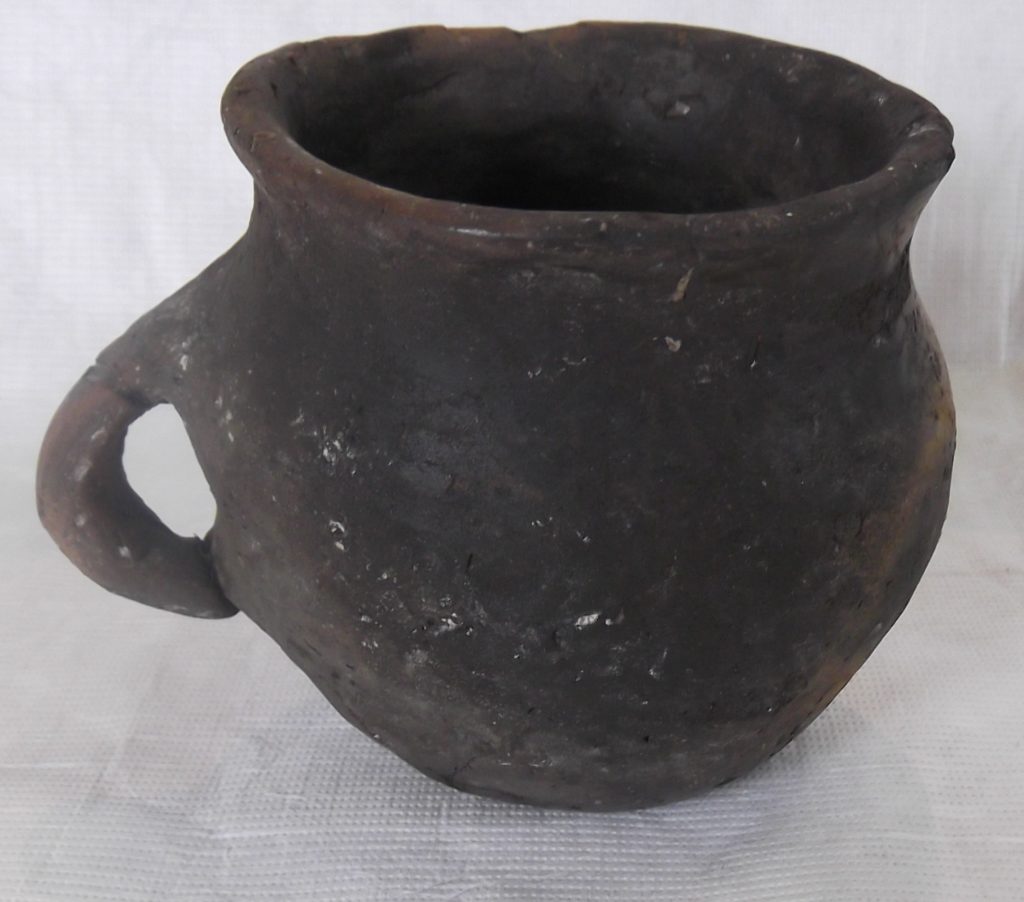

Brown Ware Mug
5th – 8th Century AD
Brown Ware
Handmade, burnished, handled pottery mug with round base, brownish ware. Found close to the head of a child. Burnishing (rubbing a pot with a leather cloth) would make the mug watertight and also a lot smoother to the touch.
Found in Bekesbourne, Kent, UK. by Mr. P.G. Wilson.
Reference: CANCM:7588
Can be found: Middle Shelf in Explorers and Collectors Collection


Bucket
5th – 8th Century AD
Copper Alloy
Bucket/vat with handle, fragments inside.
Reference: CANCM:1113
Can be found: Bottom Shelf in Explorers and Collectors Collection




































































Buckle
5th-8th Century AD
Copper Alloy
Oval copper alloy buckle with buckle plate and tongue complete.
Reference: CANCM:nn
Can be found: Top Shelf in Explorers and Collectors Collection




































































Buckle
5th – 8th Century AD
Copper Alloy
Jewelled buckle of Frankish type.
Bequeathed by Mr. J. Brent.
Reference: CANCM:2175
Can be found: Middle Shelf in Explorers and Collectors Collection




































































Buckle
5th – 8th Century AD
Copper Alloy
Small bronze buckle complete with tongue. The buckle loop is decorated with groups of incised lines and part of the buckle plate remains.
Found at Eastry, Kent in 1792. Presented to the museum by Dr. W.G. Urry after a loan from Mr Irby
Reference: CANCM:7501
Can be found: Bottom Shelf in Explorers and Collectors Collection




































































Buckle and Buckle Plate
5th – 8th Century AD
Silver gilt
Buckle, broken into two pieces, with triangular plate. Such buckles were normally found in graves of high status males and are often decorated with garnets. This is a slightly cheaper version, but would still have belonged to a rich man.
Found in Littlebourne; Long Meadow, Well Chapel, Kent, UK. by Mr. B. Riley.
Reference: CANCM:2003.389.1-3
Can be found: Top Shelf in Explorers and Collectors Collection


Buckle Plate
5th – 8th Century AD
Bronze
Bronze buckle and buckle plate inlaid with silver.
Found in Bekesbourne, Kent, UK. by Mr. P.G. Wilson.
Reference: CANCM:7537
Can be found: Middle Shelf in Explorers and Collectors Collection




































































Cloth Fragments
5th – 8th Century AD
Cloth
Fragments of cloth in glass slide.
Found adhering to the remains of an Anglo-Saxon in a grave at Sarre, Kent in 1863.
Reference: CANCM:7159
Can be found: Middle Shelf in Explorers and Collectors Collection




































































Coin
Eighth Century AD
Silver
Electroform copy of an Anglo-Saxon coin - the original is in the British Museum. This coin was minted in around 765AD for Ecgberht II, who ruled from 765 to 779. Not much is known about Ecgberht aside from his coins and the small number of charters in which he is mentioned; he was likely installed by Offa as a king. Offa then attempted to rule Kent more directly in 776, which prompted a rebellion under Ecgberht. Kent seems to have remained independent for several years afterwards, which suggests it was successful.
Reference: CANCM:10446
Can be found: Bottom Shelf in Explorers and Collectors Collection
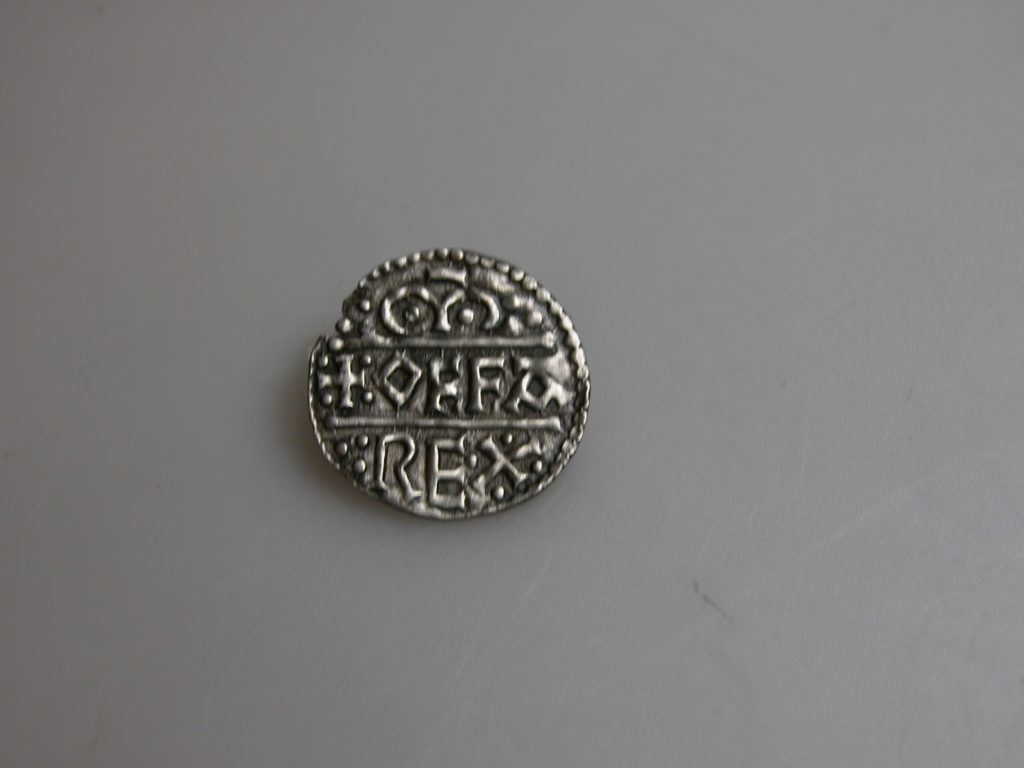

Coin
Silver
Coin minted for Archbishop Æthelheard, who was enthroned in 793. It bears the names of both the archbishop and the King. King Offa gave the Archbishops of Canterbury the right to mint their own coins, and this continued into the reign of King henry VIII.
Found by Mr David Hunt at Otford, Kent. Acquired by the Landowner with grant-aid from the MLA/V&A Purchase Grant fund, and generous contributions from Mr Hunt and from a Kent charitable trust through the friends of Canterbury Museums.
Reference: CANCM:2010.69
Can be found: Bottom Shelf in Explorers and Collectors Collection




































































Comb
8th Century AD
Antler
Fragment of double-sided antler comb. The comb is decorated with a series of ring-and-dot motifs in a triangular arrangement at its end.
Presented by Canterbury Archaeological Trust
Reference: CANCM:1986.37.382
Can be found: Top Shelf in Explorers and Collectors Collection




































































Comb
8th Century AD
Antler, iron and bone
Single-sided comb with antler handle, iron nails and bone teeth.
Excavated from Christ Church College 1993. Presented by Canterbury Archaeological Trust
Reference: CANCM:1979.64.1331
Can be found: Top Shelf in Explorers and Collectors Collection




































































Comb
9th Century AD
Bone
Worked Bone single-sided comb.
Excavated from the Marlowe Car Park 1979. Presented by Canterbury Archaeological Trust
Reference: CANCM:1980.12.269
Can be found: Top Shelf in Explorers and Collectors Collection




































































Comb Case
6th Century AD
Antler
The Anglo-Saxons kept their combs in cases to stop the teeth from breaking.
Excavated in Stour Street in 1986. Presented by Canterbury Archaeological
Reference: CANCM:nn
Can be found: Top Shelf in Explorers and Collectors Collection


Cone Jar
5th – 8th Century AD
Glass
Glass tumbler.
Found in Westbere (Anglo-Saxon cemetery) Kent, UK. Bequeathed by Osborn Dan.
Reference: CANCM:6431
Can be found: Middle Shelf in Explorers and Collectors Collection


Cone Jar
5th – 8th Century AD
Glass
Conical glass vase.
Found in Westbere (Anglo-Saxon cemetery) Kent, UK. Bequeathed by Osborn Dan.
Reference: CANCM:6428
Can be found: Middle Shelf in Explorers and Collectors Collection


Copper Alloy Bindings from a bucket
5th – 8th Century AD
Copper Alloy
Bronze bindings and handle of an Anglo-Saxon bucket mounted on a modern wooden copy by the London Institute of Archaeology.
Reference: CANCM:8529
Can be found: Bottom Shelf in Explorers and Collectors Collection


Copper Alloy Buckle
5th – 8th Century AD
Copper Alloy
Bronze buckle of Frankish type.
Bequeathed by Mr. J. Brent.
Reference: CANCM:2174
Can be found: Middle Shelf in Explorers and Collectors Collection




































































Copper Alloy relic box
5th – 8th Century AD
Copper Alloy
Donated to the museum by John Brent this relic box appears to have been found in the grave of an Anglo Saxon male. It would originally have had a lid and base and may have been used to hold oil, or ink.
Bequeathed by Mr. J. Brent.
Reference: CANCM:2190
Can be found: Middle Shelf in Explorers and Collectors Collection


Cruciform Brooch
5th – 8th Century AD
Copper Alloy
Bronze gilt brooch of cruciform shape and foreign manufacture, probably from South West Germany. This type is very rarely found in England, and another example is known from Silton, Ash, Kent.
Found by Mr. J Brent.
Reference: CANCM:2678
Can be found: Middle Shelf in Explorers and Collectors Collection




































































Crystal Sphere
5th – 8th Century AD
Crystal
Crystal sphere in a silver sling. It is not known what these spheres were used for, but they are often found in the graves of women alongside silver spoons. It has been suggested that they may have been used to symbolically purify water.
Bequeathed by Mr. J. Brent.
Reference: CANCM:2144
Can be found: Middle Shelf in Explorers and Collectors Collection




































































Crystal Sphere
5th – 8th Century AD
Crystal
Crystal ball suspended in silver sling, with silver wire ring through the top of the sling.
Found in Bekesbourne, Kent, UK. by Mr. P.G. Wilson.
Reference: CANCM:7518
Can be found: Middle Shelf in Explorers and Collectors Collection
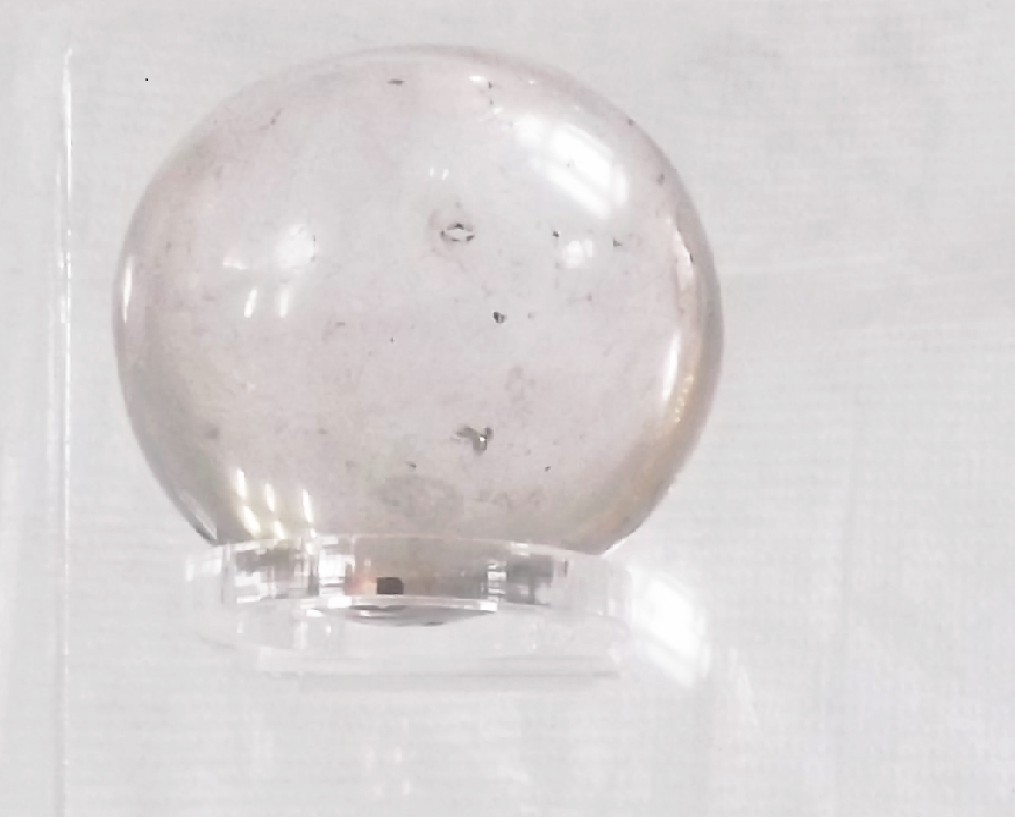


Crystal Sphere
5th – 8th Century AD
Crystal
Large crystal ball without the suspender. The purpose of Anglo Saxon crystal balls is unclear: they may have been used as a magnifying glass, or perhaps even had a magical or ritual use. They are often found in the graves of women next to silver spoons.
Reference: CANCM:2616
Can be found: Bottom Shelf in Explorers and Collectors Collection



Crystal Sphere
5th – 8th Century AD
Crystal
Large crystal ball without the suspender. The purpose of Anglo Saxon crystal balls is unclear: they may have been used as a magnifying glass, or perhaps even had a magical or ritual use. They are often found in the graves of women next to silver spoons.
Found at Mersham, Kent in 1828.
Reference: CANCM:2616
Can be found: Bottom Shelf in Explorers and Collectors Collection


Cup
Fifth to 6th Century AD
Ceramic
Ceramic mug in a brownish ware. This cup was handmade, and would have been burnished (rubbed at speed with a leather cloth) to made it more watertight.
Found in the Marlowe Car Park, 1982. Presented by Canterbury Archaeological Trust.
Reference: CANCM:nn
Can be found: Bottom Shelf in Explorers and Collectors Collection




































































Disc Brooch
Mid 5th-6th Century AD
Copper Alloy
Copper alloy disc brooch decorated with a quincunx (group of five) of cup-and-dot decorations, a favoured decorative motif in this period.
Reference: Excavated in 1978 from the Marlowe Car Park. Presented by Canterbury Archaeological Trust CANCM:1980.12.1160
Can be found: Top Shelf in Explorers and Collectors Collection




































































Disc Brooch
5th – 8th Century AD
Silver and garnet
Circular silver gilt disc brooch set with 3 square and 1 round garnet
Found in Faversham; King’s Field, Kent, by Mr. J. Brent.
Reference: CANCM:2659
Can be found: Middle Shelf in Explorers and Collectors Collection




































































Enamelled Disc
5th – 8th Century AD Copper Alloy
Enamelled disc, possibly from side of a hanging bowl and used to suspend it. Design is of celtic origin thrown up by red champleve enamel. It probably comes from Western England, or Wales.
Found in Greenwich; Tilting Yard, Kent, UK. by Mr. J. Brent
Reference: CANCM:2157
Can be found: Middle Shelf in Explorers and Collectors Collection




































































Enamelled Disc
5th – 8th Century AD
Copper Alloy
Enamelled disc, similar to above.
Found in Greenwich; Tilting Yard, Kent, UK. by Mr. J. Brent
Reference: CANCM:2158
Can be found: Middle Shelf in Explorers and Collectors Collection


Fish Brooch
5th – 8th Century AD
Copper Alloy and garnets
Cast silver fish brooch with geometric decoration and garnet set eye, fins and tail.
Found in Westbere (Anglo-Saxon cemetery) Kent, UK. Bequeathed by Osborne Dan.
Reference: CANCM:6422
Can be found: Middle Shelf in Explorers and Collectors Collection


Funnel-Shaped Vase
5th – 8th Century AD
Glass
Cone beaker, with vertical fluting and horizontal thread of opaque white glass below the rim. Cone beakers may have been used at feasts where, because they had no bases, the drinkers would have had to down the contents in one go, perhaps as a toast.
Found in Westbere (Anglo-Saxon cemetery) Kent, UK. Bequeathed by Osborn Dan.
Reference: CANCM:6429
Can be found: Middle Shelf in Explorers and Collectors Collection


Gilt Brooch or Mount
Late 6th – Early 7th Century AD
Copper alloy and gold
Gilded copper alloy small-long brooch or mount in four pieces.
Presented by Canterbury Archaeological Trust
Reference: CANCM:1988.57.3
Can be found: Top Shelf in Explorers and Collectors Collection



Gilt Pin1
5th – 8th Century AD
Copper Alloy
A highly ornamented, fine gilded, bronze pin.
Found at Guilton, Ash, Kent by Mr. Kingsford. Given to the museum by Mr J. Brent.
Reference: CANCM: 2714
Can be found: Bottom Shelf in Explorers and Collectors Collection



Gilt Pin1
5th – 8th Century AD
Copper Alloy
A highly ornamented, fine gilded, bronze pin.
Found at Guilton, Ash, Kent by Mr. Kingsford. Given to the museum by Mr J. Brent.
Reference: CANCM: 2714
Can be found: Bottom Shelf in Explorers and Collectors Collection


Girdle-Hanger
5th – 8th Century AD
Copper Alloy
Bronze girdle-hanger. This type of object, often found in Anglo Saxon women’s graves, imitates a key. It has been suggested that girdle-hangers symbolise that women controlled access to the home.
Found at Eastry, Kent in 1792. Presented to the museum by Dr. W.G. Urry after a loan from Mr Irby
Reference: CANCM:7500
Can be found: Bottom Shelf in Explorers and Collectors Collection




































































Glass Jar
5th – 8th Century AD
Glass
Green glass vessel, repaired.
Faversham, Kent, UK. Brent, J., Mr.
Reference: CANCM:2149
Can be found: Middle Shelf in Explorers and Collectors Collection


Glass jar
5th – 8th Century AD
Glass
Reference: CANCM:nn
Can be found: Bottom Shelf in Explorers and Collectors Collection


Gold Pendant
6th – 7th Century AD
Gold
Pendant. The central swastika, or Tetraskele, was used on many items in the Early Anglo-Saxon period.
Found by a metal detectorist near Manston in Kent. Acquired for the museum through the Portable Antiquities scheme.
Reference: CANCM:2014.8
Can be found: Top Shelf in Explorers and Collectors Collection




































































Gold Pendant
5th – 8th Century AD
Gold
Small gold pendant set with cross in centre.
Bequeathed by Mr. J. Brent.
Reference: CANCM:2162
Can be found: Middle Shelf in Explorers and Collectors Collection




































































Gold Pendant
5th – 8th Century AD
Gold
Small gold pendant set with garnets, may have been used as a sword bead.
Found in Anglo Saxon cemetery at Stouting, Faversham. Collected by Mr. J. Brent.
Found in Anglo Saxon cemetery at Stouting, Faversham. Collected by Mr. J. Brent.
Reference: CANCM:2161
Can be found: Middle Shelf in Explorers and Collectors Collection




































































Key
6th-7th Century AD
Copper Alloy
Key with shepherd’s crook suspension loop. It was cast in bronze and finished by hand with deeply cut out carving.
Excavated in 1978 from the Marlowe Car Park. Presented by Canterbury Archaeological Trust
Reference: CANCM:1978.3.1278
Can be found: Top Shelf in Explorers and Collectors Collection




































































Mount
5th – 8th Century AD
Copper Alloy
Bronze mount, partly gilded, with an animal design.
Found at Guilton, Kent. 1771
Reference: CANCM:2637
Can be found: Bottom Shelf in Explorers and Collectors Collection




































































Necklace
5th – 8th Century AD
Glass and Stone
String of 68 beads, of various colours.
Found in a grave in Grove Ferry, Kent. Bequeathed by Lt. Col. Copeland.
Reference: CANCM: 1975
Can be found: Middle Shelf in Explorers and Collectors Collection




































































Owl Pendant
5th – 8th Century AD
Copper Alloy
Fragment with gilt front; chip carved decoration showing a stylised owl.
Found in Barham, Kent, UK. by Mr. M. Rundle.
Reference: CANCM:1993.28
Can be found: Top Shelf in Explorers and Collectors Collection


Pendant
5th – 8th Century AD
Gold
Triangular gold pendant.
Found in Westbere (Anglo-Saxon cemetery) Kent, UK. Bequeathed by Osborne Dan.
Reference: CANCM:6426.3
Can be found: Middle Shelf in Explorers and Collectors Collection
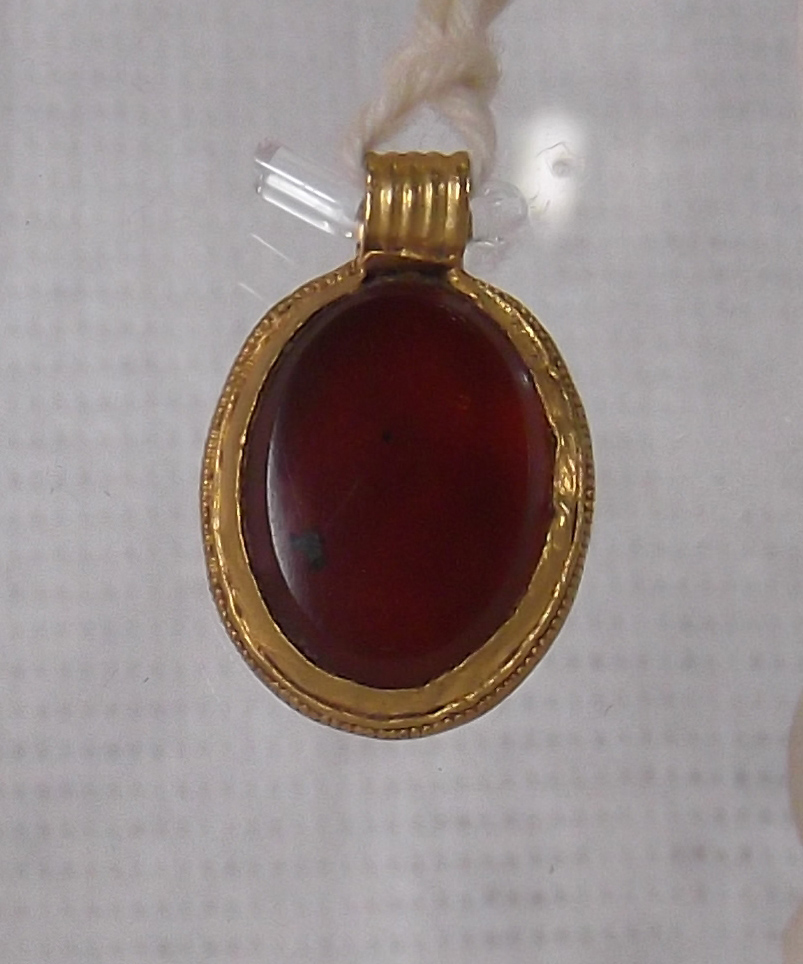

Pendant
5th – 8th Century AD
Gold
Oval gold pendant.
Found in Westbere (Anglo-Saxon cemetery) Kent, UK. Bequeathed by Osborne Dan.
Reference: CANCM:6426.2
Can be found: Middle Shelf in Explorers and Collectors Collection


Pendants
5th – 8th Century AD
Gold
Bracteate. Bracteates, thin single-sided gold medals, were worn as pendants on a string around the neck. They may have been seen as a protective amulet.
Found in Westbere (Anglo-Saxon cemetery) Kent, UK. Bequeathed by Osborne Dan.
Reference: CANCM:6426.4-6
Can be found: Middle Shelf in Explorers and Collectors Collection


Penny of King Offa
c794 AD
Silver
Coin. Minted in Canterbury for Archbishop Aethelheard during the reign of King Offa. We can date the coin to within just a few years, as Aethelheard became Archbishop in 793 and Offa died in 796.
Found by Mr D. Hunt. Purchased with the assistance of the Victoria and Albert Museum, Mr D. Hunt and Henry Moorhead and Company.
Reference: CANCM:2010.69
Can be found: Top Shelf in Explorers and Collectors Collection
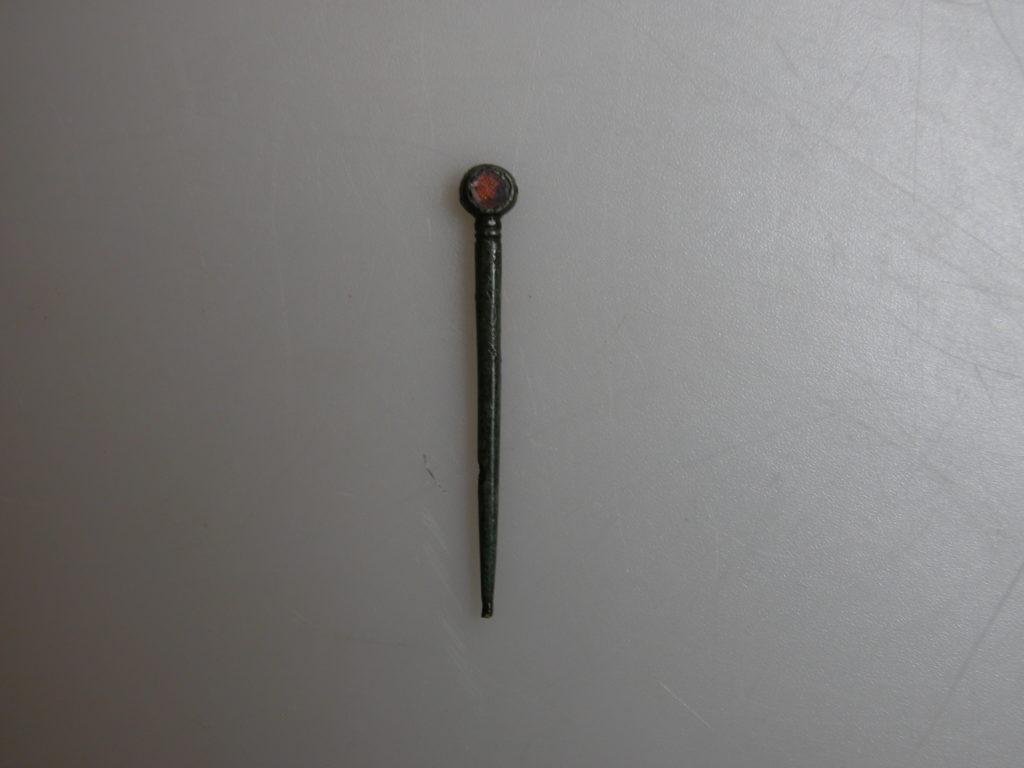

Pin
Early 7th Century AD
Copper Alloy with gold and garnet
Copper Alloy pin with a garnet set into the head. There is a piece of gold foil behind the garnet to enhance the colour of the stone.
Reference: Excavated in 1960 in Gravel Walk, Canterbury. Presented by Canterbury Archaeological Trust No accession number
Can be found: Top Shelf in Explorers and Collectors Collection




































































Pinbeaters
7th and 8th Century AD
Bone
Five worked bone double-ended pinbeaters. Pinbeaters were used while weaving to adjust the placement of threads on the loom.
Reference: CANCM:nn
Can be found: Top Shelf in Explorers and Collectors Collection




































































Pins
5th-8th Century AD
Bone
Three worked bone pins. These may have been used to hold a hair style, or perhaps to secure an item of clothing.
Reference: CANCM:nn
Can be found: Top Shelf in Explorers and Collectors Collection




































































Pyramidal Ornaments
5th – 8th Century AD
Copper Alloy
Bequeathed by Mr. J. Brent.
Reference: CANCM:2180, 2181
Can be found: Middle Shelf in Explorers and Collectors Collection


Radiate Brooch
5th – 8th Century AD
Copper Alloy
Radiate brooch, cast bronze.
Found in Bekesbourne, Kent, UK. by Mr. P.G. Wilson.
Reference: CANCM:7530
Can be found: Middle Shelf in Explorers and Collectors Collection




































































Radiate Brooch
5th – 8th Century AD
Copper Alloy
Radiate brooch, cast bronze, ring and dot and chevron decoration on bow and foot.
Found in Bekesbourne, Kent, UK. by Mr. P.G. Wilson.
Reference: CANCM:7529
Can be found: Middle Shelf in Explorers and Collectors Collection


Rune Stone
5th – 6th Century AD
Stone
Rune stone. One of the only two surviving pagan grave markers from the period. (The other is to the left of the case). They may have been made by invading Scandinavian warriors to commemorate comrades who fell in battle.
Found in Sandwich, Kent, UK. by Mr. W.H. Rolfe.
Reference: CANCM:1141
Can be found: Bottom Shelf in Explorers and Collectors Collection




































































Saucer Brooch
6th Century AD
Copper Alloy
Rare gilded bronze saucer brooch of West Saxon type, one of a pair.
Found in Faversham, Kent by Mr. J. Brent.
Reference: CANCM:2166
Can be found: Middle Shelf in Explorers and Collectors Collection


Sceat
5th – 8th Century AD
Silver
Coin. Probably known as ‘pennies’ when they were in use, these coins were minted in Kent, Frisia and Jutland. The earliest sceatta in Britain were minted in Kent and the Thames estuary.
Found in Elham; Henbury Manor, Kent, UK. by Mr. G.T. Hall.
Reference: CANCM:1993.44.1
Can be found: Top Shelf in Explorers and Collectors Collection


Sceat
5th – 8th Century AD
Silver
Coin. Probably known as ‘pennies’ when they were in use, these coins were minted in Kent, Frisia and Jutland. The earliest sceatta in Britain were minted in Kent and the Thames estuary.
Found in Elham; Henbury Manor, Kent, UK. by Mr. G.T. Hall.
Reference: CANCM:1993.44.2
Can be found: Top Shelf in Explorers and Collectors Collection




































































Shield Boss
5th – 8th Century AD
Iron
Iron shield boss. Found 9” from the grave floor and 15” from the head of the grave, suggesting that the width of shield was not more than 30”.
Found in Bekesbourne, Kent, UK. by Mr. P.G. Wilson.
Reference: CANCM:7586
Can be found: Middle Shelf in Explorers and Collectors Collection




































































Silver Ring
5th – 8th Century AD
Silver
Portion of silver twisted ring.
Found by Mr J. Brent.
Reference: CANCM:2229
Can be found: Bottom Shelf in Explorers and Collectors Collection




































































Silver Spoon
5th – 8th Century AD
Silver Gilt
Silver gilt spoon with swastika in niello on junction of bowl and handle. Found between knees of skeleton.
Found in Bekesbourne, Kent, UK. by Mr. P.G. Wilson.
Reference: CANCM:7519
Can be found: Middle Shelf in Explorers and Collectors Collection
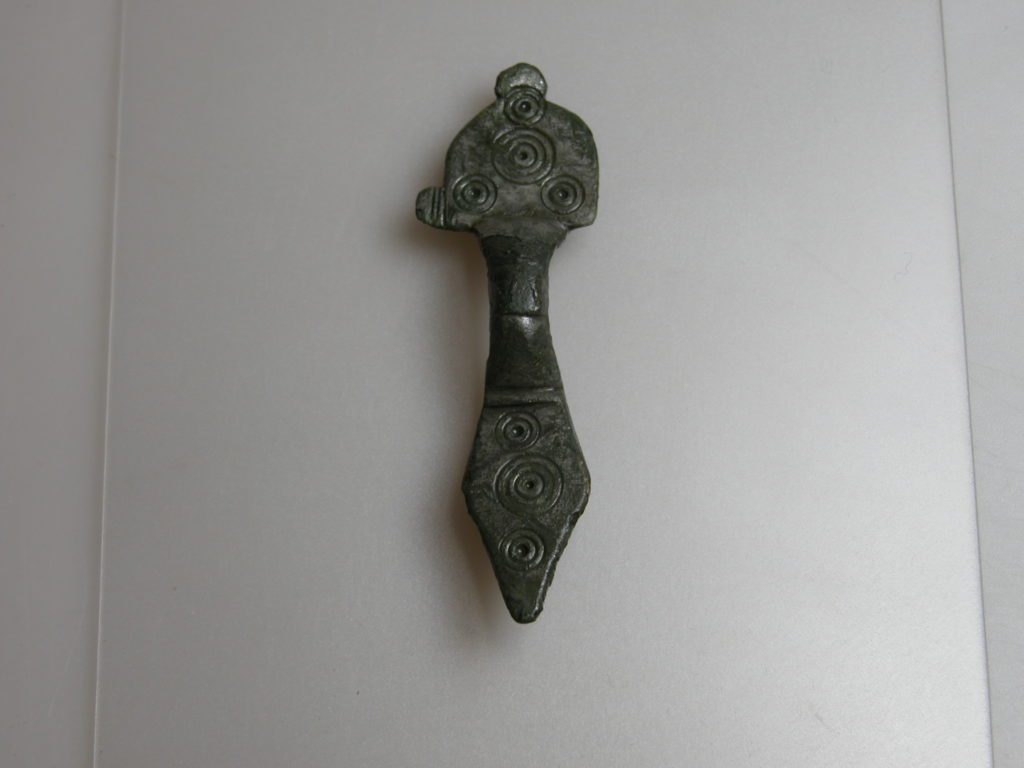

Small-Long Type Brooch
5th-6th Century AD
Copper Alloy
Copper alloy brooch with cup and dot decoration at head and foot. This type of brooch was generally worn in a pair.
Reference: CANCM:nn
Can be found: Bottom Shelf in Explorers and Collectors Collection


Small-Long Type Brooch
5th-6th Century AD
Copper Alloy
Copper alloy brooch. This type of brooch was generally worn in a pair.
Reference: CANCM:nn
Can be found: Bottom Shelf in Explorers and Collectors Collection
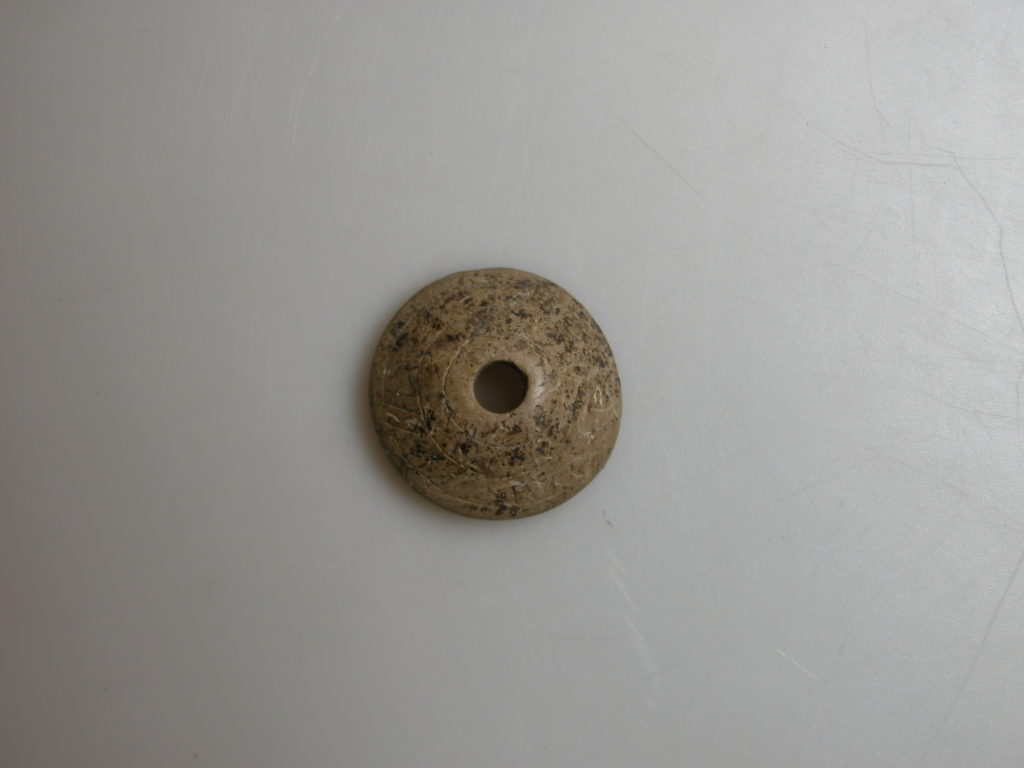

Spindle Whorl
8th Century AD
Bone
Bone spindle whorl with incised decoration. Spindle whorls were used when spinning wool into yarn. Attached to the spindle, they helped maintain the speed of the spin used to twist the raw wool into a long thread. Using a spindle whorl helped maintain the same thickness of the wool as it was spun.
Reference: CANCM:nn
Can be found: Top Shelf in Explorers and Collectors Collection


Spindle Whorl
8th Century AD
Bone
Two bone Spindle whorl.
Reference: CANCM:nn
Can be found: Top Shelf in Explorers and Collectors Collection


Spindle Whorl
5th – 8th Century AD
Glass
Spindle whorl of very dark blue or green glass with inlaid white glass decoration. Anglo-Saxon Eastry appears to have been a place of some size and much importance. The Kings of Kent had a palace, and often held court there.
Found at Eastry, Kent by Mr. Irby. Presented to the museum by Dr.W.G. Urry.
Reference: CANCM:7503
Can be found: Bottom Shelf in Explorers and Collectors Collection


Spindle Whorls
8th Century AD
Ceramic
Two Ceramic spindle whorls.
Reference: CANCM:nn
Can be found: Top Shelf in Explorers and Collectors Collection




































































Square Headed Brooch
Mid 6th Century AD
Copper Alloy
Square headed brooch decorated with the ring-and-dot motifs popular in the early Saxon period. This type of brooch is one of the most common worn by the Anglo-Saxons, and was used to secure clothing.
Reference: Excavated in 1978 from the Marlowe Car Park. Presented by Canterbury Archaeological Trust CANCM:1978.3.1124
Can be found: Top Shelf in Explorers and Collectors Collection




































































Square Headed Brooch
5th – 8th Century AD
Copper Alloy
Square-headed brooch fragment with gilding
Found in Chartham, Kent, by Mr. N. Austin.
Reference: CANCM:1996.6
Can be found: Top Shelf in Explorers and Collectors Collection




































































Square Headed Brooch
5th – 8th Century AD
Silver Gilt
Small square headed brooch, silver gilt.
Found in Bekesbourne, Kent, UK. by Mr. P.G. Wilson.
Reference: CANCM:7526
Can be found: Middle Shelf in Explorers and Collectors Collection
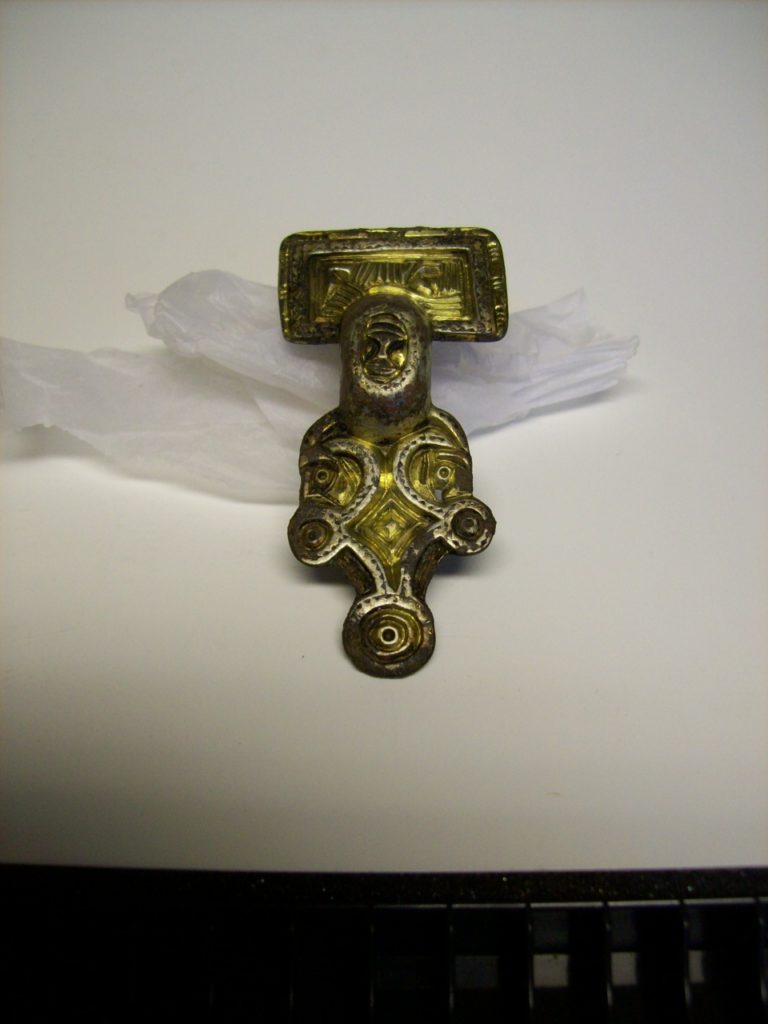

Square Headed Brooch
5th – 8th Century AD
Silver Gilt
Small square headed brooch, silver gilt.
Found in Bekesbourne, Kent, UK. by Mr. P.G. Wilson.
Reference: CANCM:7525
Can be found: Middle Shelf in Explorers and Collectors Collection




































































Square-Headed Brooch
6th Century AD
Silver Gilt
Silver-gilt square-headed brooch of a cruciform shape, jeweled and set with 9 garnets.
Found at Stowting, Kent by Mr. J. Brent.
Reference: CANCM:2677
Can be found: Middle Shelf in Explorers and Collectors Collection




































































Square-Headed Brooch
Silver
Square-headed silver-gilt brooch.
Found at Eastry, Kent in 1792. Presented to the museum by Dr. W.G. Urry after a loan from Mr Irby
Reference: CANCM:7495
Can be found: Bottom Shelf in Explorers and Collectors Collection




































































Square-Headed Brooch
5th – 8th Century AD
Silver Gilt
Square-headed silver-gilt brooch with an undivided foot and a motif decorating footplate which shows rampant animals either side of the foot reaching up to the bow.
Found at Eastry, Kent in 1792. Presented to the museum by Dr. W.G. Urry after a loan from Mr Irby
Reference: CANCM:7494
Can be found: Bottom Shelf in Explorers and Collectors Collection




































































Squat Jar
5th – 8th Century AD
Glass
Glass Vessel.
Bequeathed by Mr. J. Brent.
Reference: CANCM:2150
Can be found: Middle Shelf in Explorers and Collectors Collection




































































Squat Jar
5th – 8th Century AD Glass
Glass vessel.
Found in Faversham, Kent, UK. by Mr. J. Brent.
Reference: CANCM:2151
Can be found: Middle Shelf in Explorers and Collectors Collection


Strap End
5th-8th Century AD
Copper Alloy
A strap end would have been affixed to the end of a belt or strap of a harness as decoration. They would protect the leather end of the strap and make it easier to thread, but despite this very functional purpose they were still considered jewellery in their own right.
Found in Martyr’s Field, Canterbury, in around 1900.
Reference: CANCM:7162
Can be found: Middle Shelf in Explorers and Collectors Collection




































































Sword Ring
5th – 8th Century AD
Silver Gilt
Silver-gilt sword ring inlaid with niello.
Reference: CANCM:2003.390
Can be found: Top Shelf in Explorers and Collectors Collection




































































The Bishop Liudhard Medalet
c. 590 AD
Gold
A electroform copy of the Bishop Liudhard Medalet, now in the World Museum Liverpool. The Medalet honours Queen Bertha’s chaplain and was probably created prior to St Augustine’s arrival in 597 AD.
Original excavated from St Martin’s Churchyard in 1844.
Reference: CANCM:10353
Can be found: Bottom Shelf in Explorers and Collectors Collection




































































The Canterbury Pendant
Early 7th Century AD
Gold, Garnets, Glass
A fine example of an Anglo Saxon pendant made from a gold disc inlaid with garnets and glass. The empty central spaces would have been filled with white paste to form a cross.
Presented by Canterbury Archaeological Trust
Reference: CANCM:1982.14.23
Can be found: Top Shelf in Explorers and Collectors Collection




































































The Dragon Pendant
9th Century AD
Gold, Garnets
An animal-head pendant. It is made from a sheet of gold decorated with gold filigree and granules. One of the eye sockets is now empty, but the other has a deeply sunken garnet set in it. The decoration and style are similar to other pendants that date from the Ninth century, but the suspension loop at the back of the head is unique among Anglo Saxon finds.
Purchased with grant-aid from Arts Council England/Victoria and Albert Museum Purchase Grant Fund and the Headley Trust
Found by Mr Peter Thomas when metal detecting at Monkton, Kent in 2013.
Reference: CANCM:2016.14
Can be found: Bottom Shelf in Explorers and Collectors Collection




































































Three Stone Objects
5th – 8th Century AD
Stone
Circular stone objects, probably used in a game.
Bequeathed by Mr. J. Brent.
Reference: CANCM:2278-80
Can be found: Middle Shelf in Explorers and Collectors Collection


Tweezers
7th-8th Centuries AD
Copper Alloy
Tweezers are often found in Anglo-Saxon graves. They may have been worn on a necklace or attached to a belt, but either way their inclusion in a grave shows how dedicated the Anglo-Saxons were to personal hygiene.
Reference: CANCM:1980.11.1410
Can be found: Top Shelf in Explorers and Collectors Collection


Two Glass Beakers
5th – 8th Century AD
Glass
Two glass beakers of yellow-green glass.
Donated by Mr. John Hewett.
Reference: Cancm:9934.2 + 3
Can be found: Bottom Shelf in Explorers and Collectors Collection


Two Glass Beakers
5th – 8th Century AD
Glass
Two glass beakers.
Found in Faversham, Kent, UK.
Reference: CANCM:nn
Can be found: Bottom Shelf in Explorers and Collectors Collection


Zoomorphic Brooch
Late 6th Century AD
Copper Alloy
Cast in bronze to resemble a bird. This shape has been found both in Kent and in Northern France, and it is one of the ways we know about the close links of the Anglo Saxons across the Channel.
Excavated from a site in Castle Street in 1978. Presented by Canterbury Archaeological Trust
Reference: CANCM:1978.1.210
Can be found: Top Shelf in Explorers and Collectors Collection

